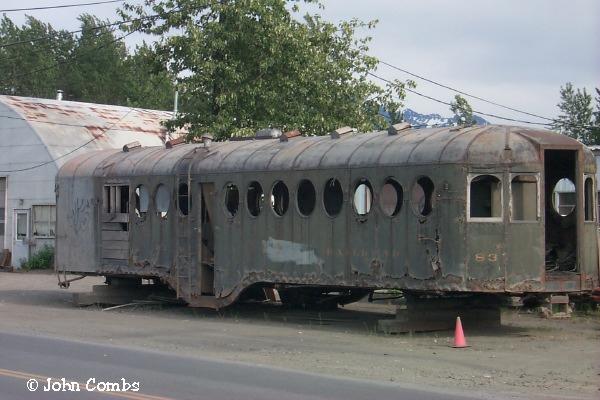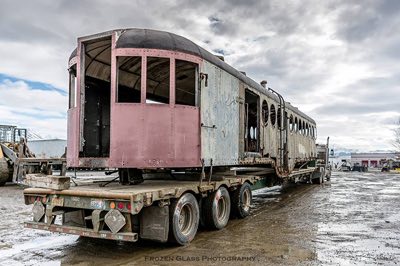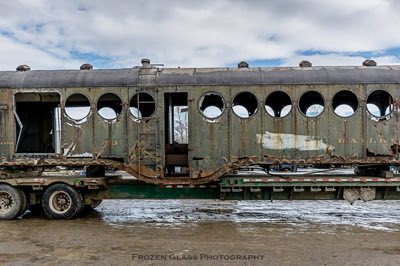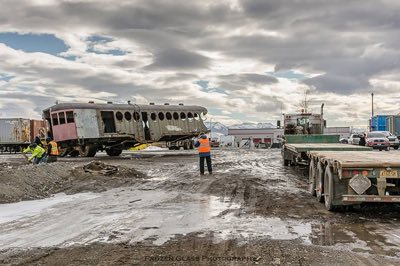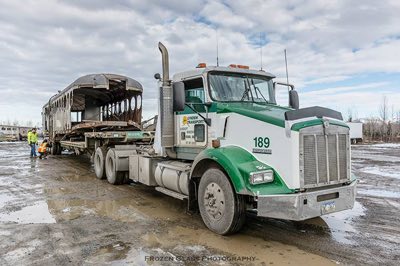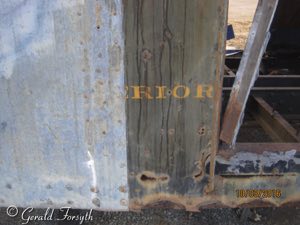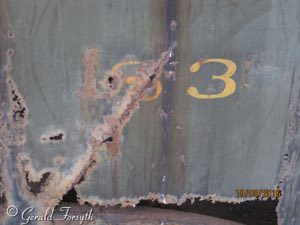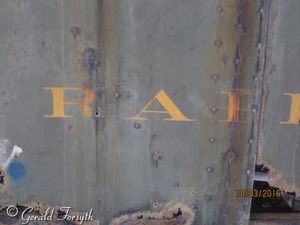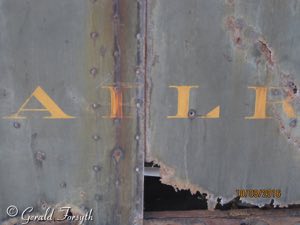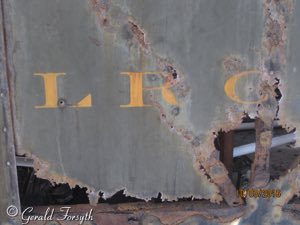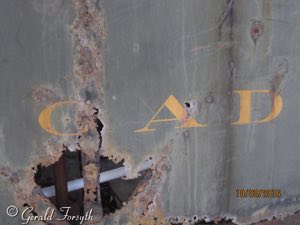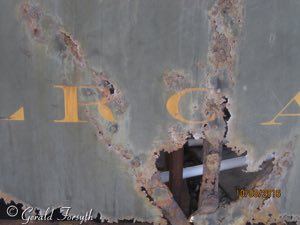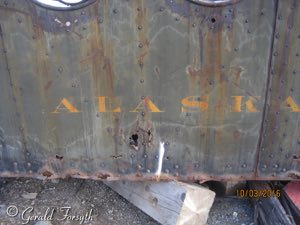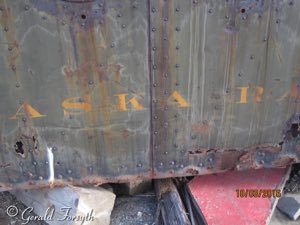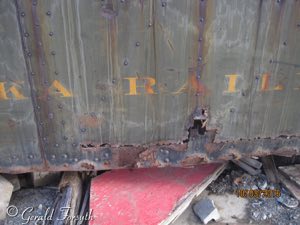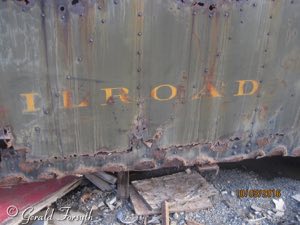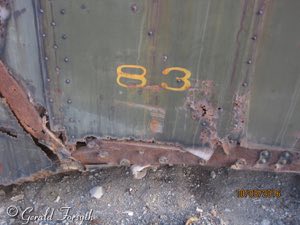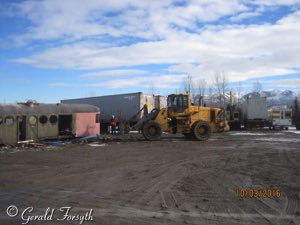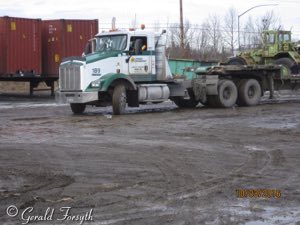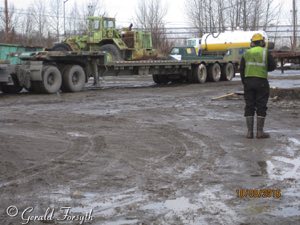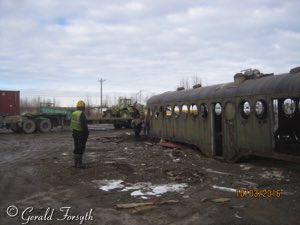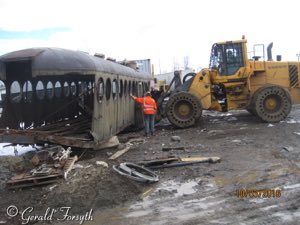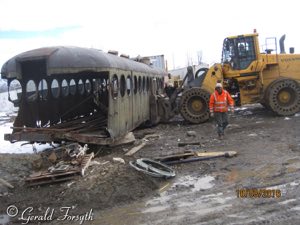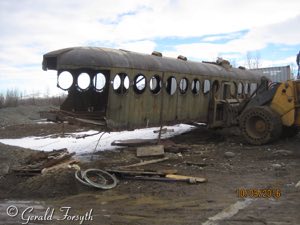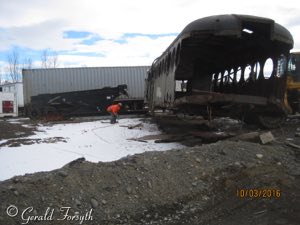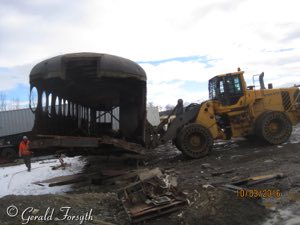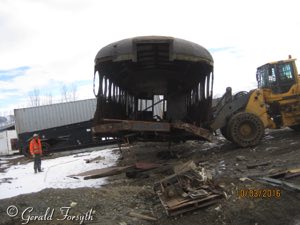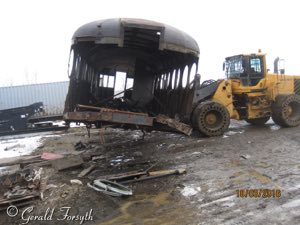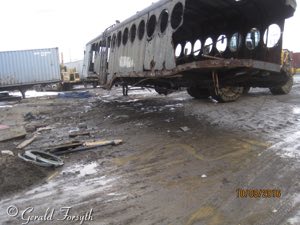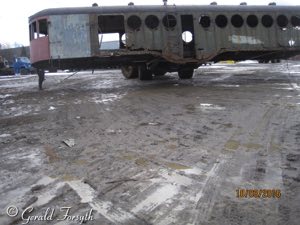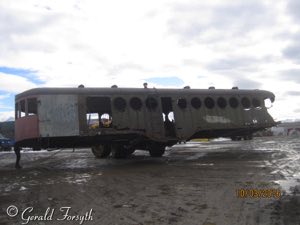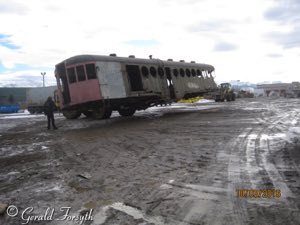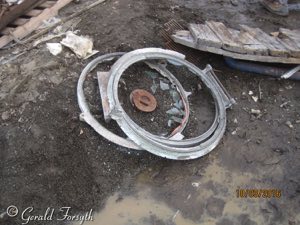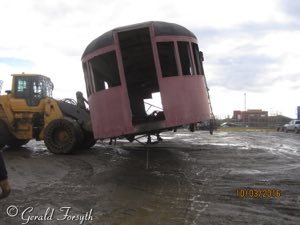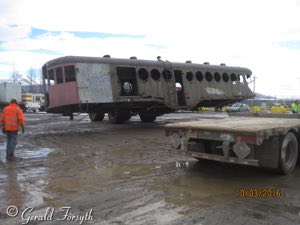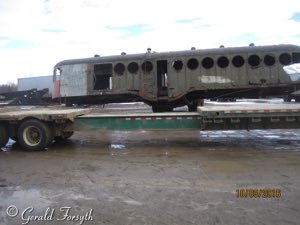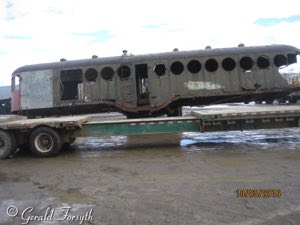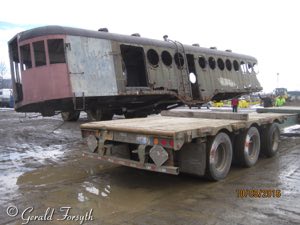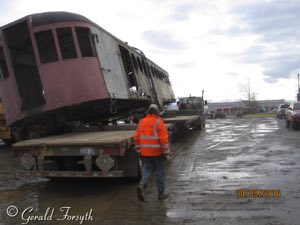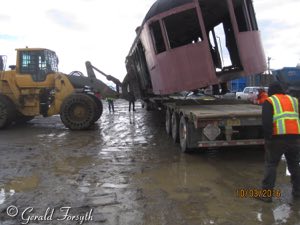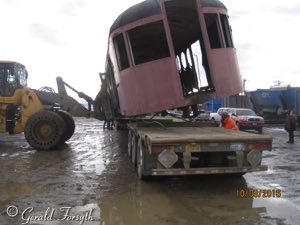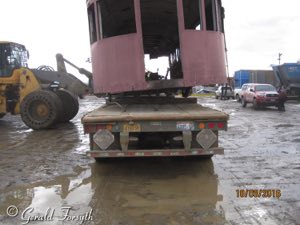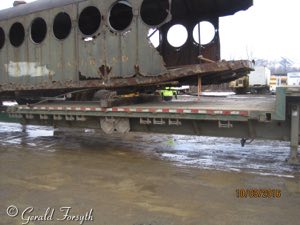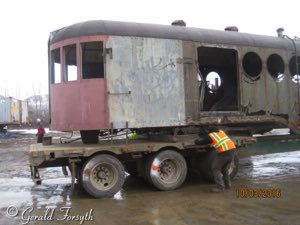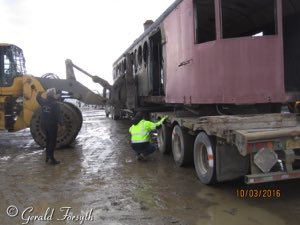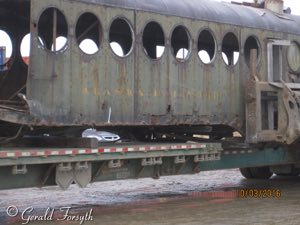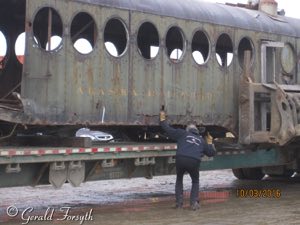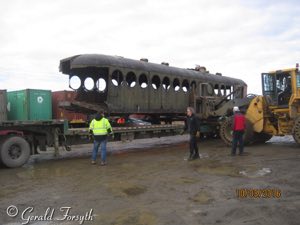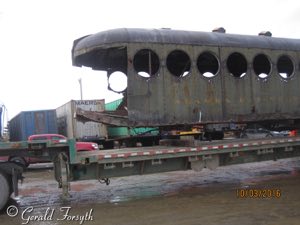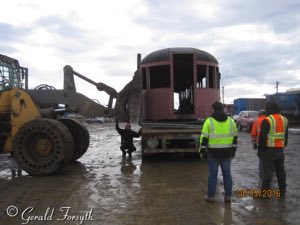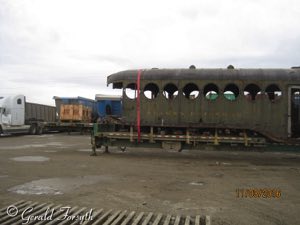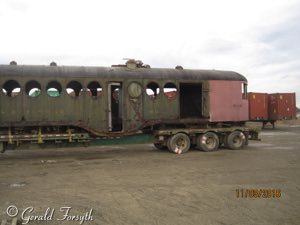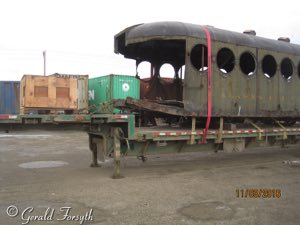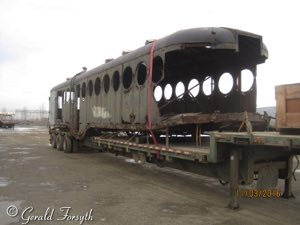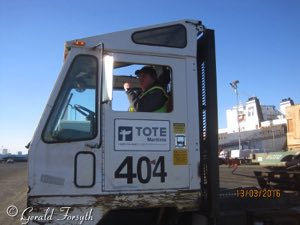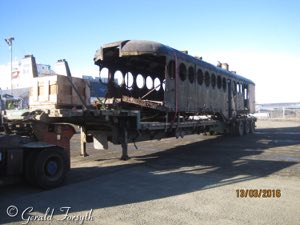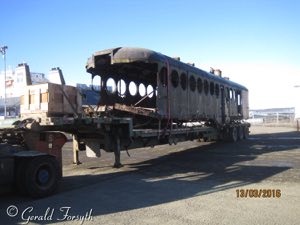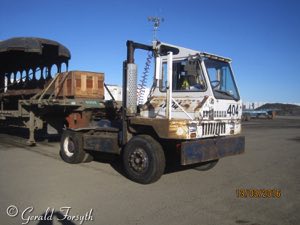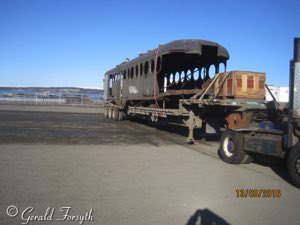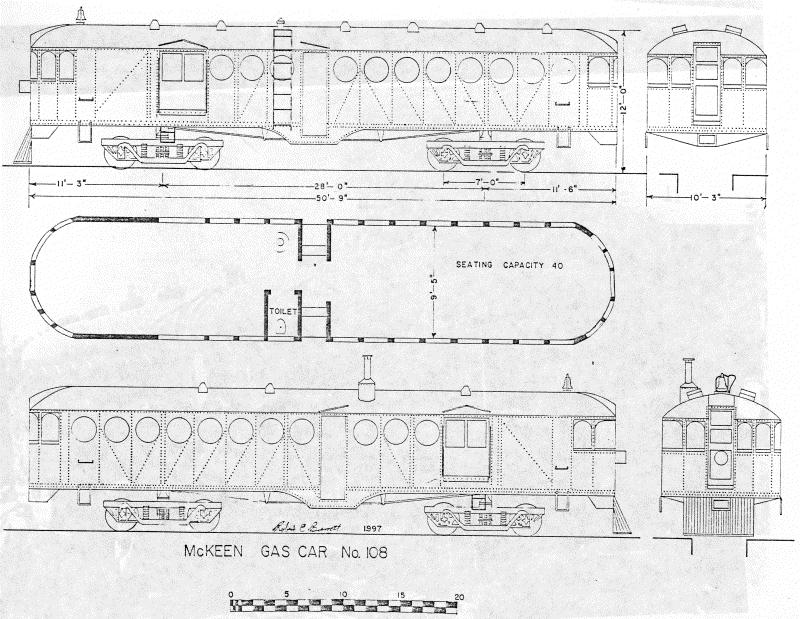Here is a pretty obscure relic that I found just outside the Anchorage Yard. It is a McKeen car, no 83. Its history is 108 McKeen Model 1910 Ex-Yuma Valley RR, acquired 1926 Baggage section added 1916, (Bureau of Reclamation), rebuilt with rounded nose, 1927 and repowered, rebuilt to unpowered combine No. 83, 1931, used by the 714th Railway Operating Battalion in 1943-44 (see photos 1 and 2), retired late 1940s, body privately owned, Anchorage, ex-San Diego Cuyamaca & Eastern, sold 1912. If you think the outside needs a little work, just check out the inside! Added 1/12/1999: The only McKeen Car to see service in Alaska has been pulled from the weeds, and a restoration project by its new owner Pat Hickey has begun. Pat thinks he may have a line on a set of trucks in Nevada, and he hopes to restore it to the way it appeared about the beginning of WWII when it saw service here between Fairbanks and College before being used as a mobile post-exchange by the Army during the war. Added 11/30/2001: McKeen Car Preservation, Based on an email from Pat Hickey. Richard MacNally is doing the work as time and money permits. Richard has restored large components including a train car or two. He recently subbed a paint job on an ARR coach in Hobb's Bldg. (the old power plant). My son James owns the train, but he's currently working in Silicon Valley. The McKeen is on an ARR leasehold lot at 826 Whitney Rd. I'll keep you posted on this project which is, at this point, more a preservation than a restoration. Check out the roof in the image. When we get the car closed up we'll use it for a shop and storage until the next stage. Also, we've got heat in the front half. I was in contact with the Pat Hickey. Although he began preservation efforts in November 2001he sold it to Anchorage Historic Properties in 2004. Added 11/23/2004: McKeen car status, By Gina Hollomon, Executive Director, Anchorage Historic Properties, inc. - "We are moving right along with her. Our next major step is to decide what kind of running gear to use. That way if we have to modify the frame, we can do so while that is easy. I would be happy to send you photos if you are interested in posting them to your website. She is a pile of rust and rivets now...mainly rust...but she will be 'wearing red paint' again before we know it! We are on a four year plan to have the restoration complete by her 100th birthday, July 2008. I fell in love with this train many years ago and can't tell you how happy I have been to be a major player in her restoration." Added 7/7/2008: I was able to learn its hiding place of the McKeen car and a friend drove me out to the storage site. It's going to need a lot of work and TLC. Added 7/13/2010: I again checked on the McKeen car. It was located under a large white canvas enclosure on Orca Street. I had become a little concerned since the Anchorage Historic Properties website had disappeared since my last railcar visit. However, once I drove onto Orca Street I immediately spotted the ginormous white canvas enclosure. I peaked through the window on the front door and saw the McKeen car was still there. Unfortunately, it appeared unchanged since my 2008 visit. Added 11/2013: The McKeen car was parked on Municipal property (Orca Street) and had become a homeless camp. Anchorage Historic Properties had to rent storage space at a scrap lot on King Street. 1/15/2014: I was contacted by Madison Kirkman who is interested in obtaining the McKeen car and bringing her to Ramona, California for restoration. Madison will contact Anchorage Historic Properties to inquire into the purchase of the car. Here is hoping Madison can secure the car and do a total restoration! Added 11/4/2015: McKeen Car Cuyamaca Restoration Update, By Madison Kirkman - "Thank you for keeping your trust in this project, we have had a few bumps here and there, the biggest and most recent has been that the Alaska Railroad, after looking at the car stated that it was too fragile to move by rail. 10 months in, and we had to start the process of getting quotes all over. This may have been a good problem, because before I tried to get quote for the Railroad to move it, I got a quote from a trucking company to move it, and from Anchorage to Seattle alone was going to be $15,000. The other company I tried to get a quote from said straight up they couldn't (or wouldn't) do it. Recently, however, I got a new quote to move it the entire distance from Anchorage, AK., to Ramona, Cal. and some how the cost for the entire move, which includes a steamship/barge move from Alaska to Tacoma is going to be $10656.95. We are going to to look into it more, but if the car can be kept intact, it will be. Again, thanks for waiting this whole time to see little done, we will post more in a the next week or so on any updates." Added 3/12/2016: The McKeen car prepares to leave the state of Alaska. Madison Kirkman says, "Here are a few of the photos the photographer shared with me. As of Sunday afternoon, the car should be on a steamship heading south to Ramona by next Thursday, so I will have more photos by Monday the 21st." Added 3/10/2016: Loading the McKeen car for shipment
For more information click on the links below:
General History William R. McKeen, Jr., Superintendent of Motive Power for the Union Pacific, in 1905 designed and built the first McKeen motor car in their shops in Omaha. In the following 3 years a number were built to supplant steam trains on lightly traveled branch lines. In 1908 the demand had become so great that Edward H. Harriman, who controlled both the Union Pacific and Southern Pacific, financed the McKeen Motor Car Company, and production was started in an old shop building in Omaha. William R. McKeen, Jr. in his design and construction of these motor cars, was far in advance of his time. The wind-splitting front end, the streamlined design throughout, the heavy steel underframe, the all-steel body construction, the center entrance and his use of what were the most powerful marine-type gasoline engines at that time all point to his genius and ingenuity. Over 50 railroads operated these motor cars. Among the trunk lines to purchase them new were the Union Pacific, Southern Pacific, Northern Pacific, Pennsylvania, Illinois Central, Rock Island, Chicago Great Western, Chicago & North Western, Erie and Soo Line. Some short lines operated no other passenger equipment. The standard model was 55 feet in length although some 70-foot cars were built. Passenger trailers were 50 feet long and mail-baggage trailers were 31 feet. These latter cars were originally built with a 4-wheel truck, but most railroads soon rebuilt them with double trucks. All the motor cars were built with steel bodies, pointed fronts, round backs, port-hole windows and center entrances. Their gasoline engine was mounted crosswise in the front truck with a big flywheel protruding beyond the left-side truck frame. This engine was geared only to the front axle which had 42 inch wheels. The rear axle had 33 inch wheels. It was equipped with a chain drive, an air clutch and had a two-speed transmission. As built by the McKeen Motor Car Company, the cars had no reverse gears, and to back up it was necessary to stop the motor and re-start it in the opposite direction after shifting the cam shaft. This proved so troublesome that most railroads installed their own reverse gears. A total of 152 McKeen cars were built between 1905 and 1917. They were not very durable and had a tendency to shake themselves apart after a few years of operation. You'll find more McKeen information here. Check out this August 9, 2003 Anchorage Daily News article Keen on a McKeen And you'll find even more McKeen history by reading Born Thirty Years Too Soon Two photos from the Don Marenzi collection (1, 2) From Bernadine Prince's book, The Alaska Railroad, Chapter IV, The Difficult Years, 127, "McKeen car No. 108, which was purchased from the Bureau of Reclamation secondhand, underwent extensive remodeling. The car was equipped with Oneida power units consisting of two Maodel H 104 H.P. Red Seal Continental motors with dual controls, replacing obsolete gas engine drive. Changes were also made i the body and superstructure design. New trucks were built to accommodate the new underslung motors. The car was placed in service in September between Fairbanks and College.
|
